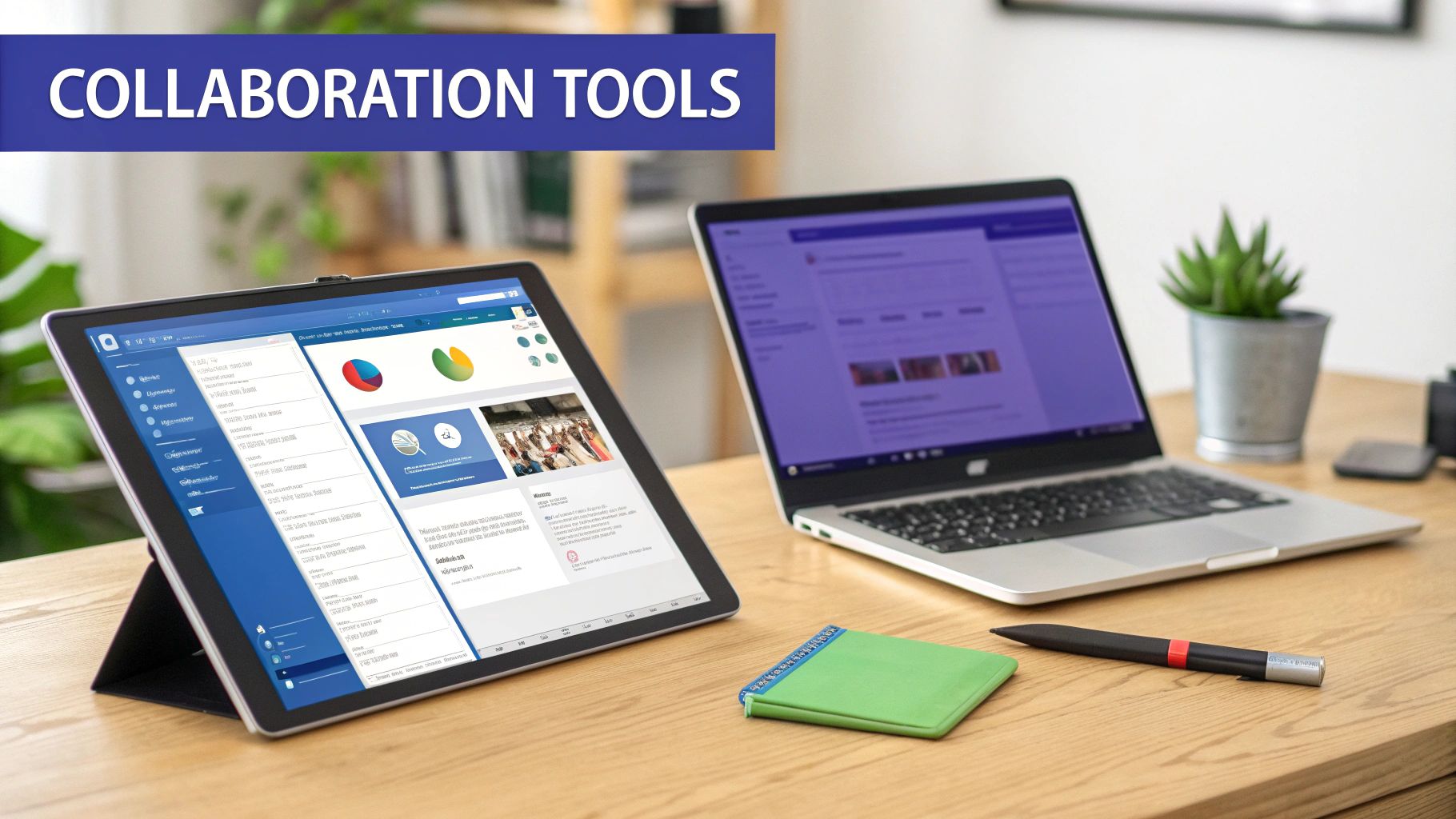The New Reality: Navigating The Distributed Workforce Landscape

The modern workplace has changed dramatically. Distributed teams are now the standard, not the exception. This shift, accelerated by the pandemic, presents both exciting opportunities and significant challenges for businesses worldwide. It demands a fresh perspective on leadership, communication, and team management. This section explores this trend's evolution, its impact on businesses, and the vital strategies for thriving in this new environment.
The Rise of The Distributed Workforce
The move to distributed work wasn’t sudden. Technology has steadily reduced the need for a centralized office for years. The COVID-19 pandemic, however, acted as a catalyst. It forced companies to quickly adopt remote work models, demonstrating that distributed teams could be highly productive, sometimes even more so than traditional office setups. This realization has persuaded many companies to adopt distributed work as a long-term strategy.
This shift has also empowered employees seeking greater flexibility. With this new level of control over their work environment, many individuals are now actively pursuing opportunities with companies embracing this distributed model.
Embracing a Global Talent Pool
One of the biggest advantages of distributed teams is access to a global talent pool. Unconstrained by location, organizations can recruit the best people for the job, regardless of where they live. This access to diverse skills and perspectives fuels innovation and boosts team performance. Imagine a US-based company hiring a software developer in Europe and a marketing specialist in Asia, creating a truly dynamic, international team. This isn't just beneficial for the company; it also opens doors for individuals seeking flexible work.
To understand this growth better, let’s take a look at some key metrics. The following table illustrates the expansion of remote work over recent years and offers projections for continued growth.
Remote Work Growth Statistics
Key metrics showing the expansion of distributed teams over recent years
| Year | Percentage of Remote Workers | Projected Growth |
|---|---|---|
| 2020 | 20% | – |
| 2023 | 28% | – |
| 2028 (Projected) | – | Potential increase to represent 85% of companies maintaining or increasing remote roles |
This table clearly demonstrates the significant increase in remote work from 2020 to 2023, with a jump from 20% to 28% of employees working remotely globally. The projected growth over the next five years further underscores the need for businesses to adapt and prepare for a future where distributed teams are dominant. More insights into these trends can be found here: Learn more about remote work trends
However, navigating this new landscape requires addressing the unique challenges that arise. For example, maintaining regulatory compliance across diverse geographical locations is a significant hurdle. Surprisingly, fewer than 4% of companies are using external tools for compliance, while a substantial 61% are spending over $10,000 annually and dedicating more than 100 hours of personnel time to these efforts.
The Future of Work: Distributed and Hybrid Models
The future of work is undoubtedly distributed. While some may return to fully in-person models, most are adopting hybrid or fully remote structures. This requires a fundamental shift in leadership. Managers must develop new skills to effectively lead remote teams, fostering communication, collaboration, and trust across distances. This includes leveraging technology like Slack for communication and project management tools like Asana for task management, establishing clear communication protocols, and rethinking performance management for a distributed workforce. Success in the coming years will hinge on the ability to navigate this new landscape effectively.
The Double-Edged Sword: Maximizing Benefits, Conquering Challenges

Managing distributed teams presents a unique duality. It offers incredible potential while simultaneously introducing new complexities. This section explores the compelling advantages and inherent obstacles of this model, providing a balanced perspective for successful implementation. Are you ready to unlock the power of a global workforce?
Reaping the Rewards: The Advantages of Distributed Teams
Distributed teams offer a wealth of benefits that can significantly contribute to organizational success. A primary advantage is access to a wider talent pool. Removing geographical limitations allows companies to recruit specialists from anywhere in the world. This fosters diverse teams, rich in varied perspectives, ultimately boosting creativity and problem-solving.
Imagine having the best minds working for you, regardless of their location. That's the power of distributed teams.
Another key benefit is increased productivity. Freed from the typical office distractions, team members can often concentrate more effectively. This translates into improved output and faster project completion. In fact, studies show 77% of workers report increased productivity while working from home. Find more detailed statistics here.
Finally, cost savings are a compelling advantage. Organizations can reduce overhead by minimizing or eliminating physical office space. This frees up resources for crucial investments in areas like technology and employee development.
Navigating the Pitfalls: Challenges in Managing Distributed Teams
While the benefits are undeniable, managing distributed teams also presents unique challenges. Communication barriers can arise due to distance, time zones, and cultural differences. Misunderstandings and communication delays can impact project timelines and team morale.
Building a strong team culture can also be difficult. Fostering trust, collaboration, and a sense of belonging requires proactive strategies. Regular virtual team-building activities and online social events can help bridge the distance.
Effective performance management is another key challenge. Traditional performance metrics may not be suitable, requiring managers to develop new methods for monitoring progress, providing feedback, and addressing performance issues remotely. This often involves a shift towards outcome-based evaluations and regular communication.
The following table summarizes the benefits and challenges, along with potential mitigation strategies. It provides a clear overview of the complexities involved in managing distributed teams and offers practical solutions for overcoming these obstacles.
Distributed Teams: Benefits vs. Challenges
Comprehensive comparison of advantages and obstacles in managing remote teams
| Category | Benefits | Challenges | Mitigation Strategies |
|---|---|---|---|
| Talent Acquisition | Access to a wider talent pool | Difficulty assessing cultural fit remotely | Implement robust virtual interview processes, including cultural assessments |
| Productivity | Increased productivity due to fewer distractions | Potential for isolation and decreased collaboration | Utilize collaborative tools and schedule regular virtual team meetings |
| Costs | Reduced overhead costs (office space, utilities) | Increased costs for technology and remote work infrastructure | Carefully plan and budget for remote work expenses |
| Communication | Flexible communication across time zones | Communication barriers and potential for misinterpretation | Establish clear communication protocols and utilize diverse communication channels |
| Culture | Enhanced work-life balance for employees | Difficulty building team cohesion and fostering a strong company culture | Prioritize virtual team building activities and promote regular social interaction |
| Performance Management | Greater employee autonomy and flexibility | Challenges in monitoring performance and providing effective feedback | Implement outcome-based performance evaluations and regular check-ins |
By understanding these key challenges and implementing the suggested strategies, organizations can effectively navigate the complexities of managing distributed teams.
Bridging the Gap: Strategies for Success
Successfully managing distributed teams requires acknowledging both the upsides and the downsides. By implementing proactive strategies, organizations can harness the advantages while mitigating the potential pitfalls.
- Establish Clear Communication Protocols: Implement clear guidelines for communication frequency, preferred channels (email, instant messaging, video conferencing), and expected response times. This clarity helps prevent confusion and ensures timely information flow.
- Invest in Collaboration Tools: Utilize technology that facilitates seamless communication and collaboration, such as project management software (Asana), shared document platforms, and video conferencing tools like BugSmash. This creates a virtual workspace that connects team members.
- Promote a Culture of Trust and Transparency: Foster open communication and encourage team members to share their thoughts and concerns openly. This cultivates trust and strengthens relationships, regardless of physical distance. Regular check-ins and virtual team-building activities contribute significantly to this goal.
- Embrace Flexibility: Recognize that distributed teams thrive on flexible work arrangements. Provide autonomy and empower team members to manage their own schedules, while maintaining accountability for results.
- Prioritize Team Building: Facilitate opportunities for team members to connect personally. Virtual coffee breaks, online games, and team-building exercises create a sense of community and improve team cohesion.
By proactively addressing the challenges and building a strong foundation, organizations can harness the power of a global workforce. Distributed teams offer significant benefits, including access to a global talent pool and increased productivity. By 2025, businesses are predicted to leverage remote work even more effectively. Companies like Google, Amazon, and Microsoft have successfully implemented remote hiring, demonstrating that large corporations can thrive with distributed teams. Explore this topic further. Don't be left behind – embrace the future of work.
Crafting Culture Across Continents: Beyond Virtual Happy Hours

Building a thriving remote team culture takes more than just occasional online social events. It requires a dedicated and proactive strategy focused on fostering authentic connections and a shared sense of purpose, regardless of location. This section reveals how successful remote-first companies build strong, vibrant cultures that transcend geographical boundaries.
Establishing Meaningful Cultural Touchpoints
For a distributed team to truly flourish, its members must connect with the company's mission and each other. This means creating regular opportunities for interaction beyond project discussions. Think of these as virtual water coolers, fostering informal conversations and relationship building.
Virtual coffee breaks or casual online social events encourage personal connections. This is crucial for building trust, especially among remote colleagues. These seemingly small interactions can make a big difference in creating a sense of belonging.
Celebrating both individual and team accomplishments is also vital. This reinforces shared success and doesn't require grand gestures. Small acknowledgements, like a personalized message or a shout-out during a team meeting, can significantly boost morale and reinforce a sense of community.
Onboarding for Remote Success
Onboarding new remote team members is particularly critical. Onboarding processes should be designed for quick and effective integration, going beyond simply providing tools and logins. It involves establishing clear communication channels and expectations from day one.
Assigning a "buddy" to new hires is a powerful approach. This seasoned team member provides guidance, answers questions, and offers support as the new hire navigates the company culture and their role. This buddy system fosters a sense of belonging and helps integrate new hires more smoothly.
Building Traditions That Strengthen Team Identity
A strong team identity requires shared experiences and traditions. These traditions can be unique to the team, reinforcing shared values and goals. A monthly virtual team lunch, where everyone orders from a local restaurant and eats together online, fosters camaraderie and connection across distances.
Furthermore, the shift towards distributed teams is fueled by the desire for flexibility and cost savings. A staggering 98% of employees desire continued remote work. This trend is reflected in the projected growth of remote work, with estimates suggesting a significant portion of the workforce will be remote by 2025. Upwork, for instance, predicts 32.6 million Americans will work remotely in the coming years. Discover more insights about remote work statistics. This reinforces the importance of establishing a robust culture for effective distributed team management. Companies also benefit from reduced overhead by downsizing physical offices, allowing for reallocation of resources.
Fostering Psychological Safety in Distributed Teams
Fostering psychological safety is paramount. Team members must feel comfortable expressing opinions, sharing ideas, and asking questions without fear of judgment. This encourages open communication and collaboration, crucial for innovation and problem-solving.
When team members feel safe, they contribute their best work and engage more fully with colleagues. This creates a positive feedback loop of trust, collaboration, and high performance, driving success for the entire team and leading to greater innovation and higher-quality output.
The Digital Backbone: Technology That Actually Empowers Teams

Successfully managing distributed teams depends heavily on the right technology. It's not enough to simply have various tools. You need an integrated digital ecosystem that streamlines workflows and strengthens team connections. This exploration reveals the key technologies and strategies for empowering your remote workforce.
Building Your Tech Stack: Essential Tools for Distributed Teams
Think of your tech stack as the central nervous system of your distributed team. It needs to facilitate seamless communication, efficient collaboration, and effective project management. This starts with a robust communication platform. Tools like Slack or Microsoft Teams offer instant messaging, video conferencing, and file sharing, enabling real-time interaction regardless of location.
Consider project management software as well. Platforms like Asana or Trello provide a centralized hub for task management, progress tracking, and deadline management. This keeps everyone aligned and ensures projects stay on track.
Finally, cloud storage solutions are critical. Services like Google Drive or Dropbox allow for secure file sharing and version control, simplifying collaboration. This eliminates excessive email attachments and keeps everyone working with the latest versions. Want to learn more about working offline? Check out this helpful guide: How to master offline mobile collaboration.
Synchronous vs. Asynchronous Communication: Finding the Right Balance
Effective communication is crucial for any team, especially distributed ones. Understanding synchronous and asynchronous communication is key. Synchronous communication, such as video meetings, requires everyone to be present simultaneously. This works well for brainstorming and team discussions.
Asynchronous communication lets team members contribute at their own pace. Email, project management updates, and shared documents are examples. This is perfect for focused individual work. Finding the right balance for your team and tasks is vital. Too many real-time meetings can be draining, while relying solely on asynchronous methods can lead to isolation.
Security Considerations for Distributed Workforces
With team members accessing data from various locations, security is paramount. Robust security measures are essential. This includes multi-factor authentication, VPN access, and regular security training. It’s like securing your home, even when everyone’s inside. Protecting sensitive data is non-negotiable.
Choosing tools with strong security features is also crucial. Prioritize platforms with end-to-end encryption and compliance with relevant data privacy regulations. This protects your information and builds trust within your team.
Creating Technology Standards: Balancing Team Needs and Cohesion
While individual preferences matter, establishing technology standards is key for cohesion. Imagine a team using a mix of Slack, email, and other platforms for communication—chaos ensues.
Implementing standard communication protocols and preferred tools keeps everyone aligned. This isn’t a one-size-fits-all approach. It’s about finding tools that meet core team needs while allowing flexibility. A team might standardize on Slack for messaging but allow individual note-taking app preferences. Asana experts Joshua Zerkel and Jessica Gilmartin emphasize how cultural differences significantly impact communication styles within distributed teams. They stress the importance of understanding cultural norms related to feedback, seeking help, and even casual conversations. This awareness allows leaders to adapt their communication style and manage expectations effectively. They also highlight the importance of clear, concise writing, as English may not be everyone's first language. By being mindful of these nuances, leaders create a more inclusive and effective communication environment.
This strategic approach to technology empowers distributed teams to work seamlessly, regardless of location. It fosters connection, enhances communication, and maximizes productivity.
Communication That Connects: Beyond Basic Video Calls
Effective communication is the very foundation of any successful team, but its importance is magnified when managing distributed teams. When team members are spread across different time zones and continents, seemingly minor misunderstandings can rapidly escalate into significant obstacles. This section explores the communication frameworks that top-performing remote organizations use to overcome distance, cultural differences, and the inherent challenges of asynchronous work.
Designing Communication Protocols: Balancing Real-Time and Asynchronous Needs
Creating a robust communication strategy for distributed teams begins with understanding the nuances of different communication styles. Synchronous communication, such as video calls using platforms like Zoom, requires everyone to be present simultaneously. This format excels for brainstorming sessions, rapid problem-solving, and fostering team rapport.
Asynchronous communication, conversely, allows team members to contribute on their own schedule. This includes communication methods like email, shared documents, or project management platform updates. Asynchronous communication is perfect for focused, uninterrupted work and accommodating team members in various time zones.
The true magic lies in finding the optimal balance for your specific team. Over-relying on synchronous communication can result in meeting fatigue, while exclusively asynchronous methods can diminish team cohesion.
Choosing the Right Channels for Different Information Types
Certain types of information are best conveyed through specific communication channels. Quick questions or informal updates are perfectly suited for instant messaging platforms like Slack. Detailed project discussions or complex problem-solving often benefit from the richness of video conferencing.
Formal announcements or company-wide updates are best delivered through email or a dedicated communication platform. Clearly defining which channel to use for various information types minimizes confusion and streamlines the flow of information. This ensures that messages reach the intended recipients promptly, maximizing efficiency and minimizing potential frustration. For streamlined workflows and enhanced team collaboration, explore HR Digital Transformation strategies.
Documentation: Creating Institutional Knowledge
In a distributed environment, clear, concise, and easily accessible documentation is paramount. Consider it your team's central repository of knowledge. A well-maintained wiki or internal knowledge management system like Confluence empowers team members to quickly find the information they need, regardless of their location or time zone.
This not only boosts productivity but also cultivates a sense of self-sufficiency within the team. Furthermore, documenting processes and decisions creates valuable institutional knowledge, ensuring continuity even when team members transition to new roles or depart the company.
Fostering Transparency and Preventing Information Silos
Transparency is the cornerstone of trust within distributed teams. Regularly sharing company updates, project progress, and even challenges fosters a sense of shared purpose and mitigates uncertainty. This doesn't mean overwhelming your team with an avalanche of information.
The key is to be strategic about what you share and how you share it. Utilize designated communication channels for different types of updates and ensure that everyone has access to the same information. This prevents information silos from developing between different locations or departments. Moreover, encourage open dialogue and create opportunities for team members to ask questions and provide feedback.
Facilitating Engaging Virtual Meetings
Virtual meetings have the potential to be highly productive or a significant drain on time and energy. To ensure your virtual meetings are engaging and effective, establish clear agendas in advance. This allows participants to prepare adequately and ensures everyone is aligned.
Encourage active participation by using interactive tools like polls or breakout rooms. Maintain conciseness and focus during meetings, respecting everyone's time. Finally, don't neglect the human element.
Begin with a few minutes of informal conversation to build rapport and foster connection before delving into business matters. Even small gestures like this can significantly contribute to a positive and productive virtual meeting environment. Communication experts like Joshua Zerkel and Jessica Gilmartin underscore the importance of acknowledging cultural differences in communication styles, particularly when delivering feedback or leading meetings. They advocate adapting communication approaches to respect cultural norms, ensuring that everyone feels heard and understood. For instance, some cultures may be more direct with feedback, while others favor a more nuanced approach.
Beyond Surveillance: Performance Management That Builds Trust
Managing a distributed team's performance demands a new way of thinking. Traditional, observation-based methods are ineffective when you can't physically see your team's daily work. Instead, successful remote leaders embrace outcome-based performance management, prioritizing results and trust over constant oversight.
Establishing Clear Expectations and Meaningful Metrics
Effective performance management for distributed teams starts with crystal-clear expectations. This begins by defining SMART goals: Specific, Measurable, Achievable, Relevant, and Time-bound. When everyone understands the shared objectives, it cultivates purpose and accountability. These goals should also align with overall company objectives, ensuring everyone contributes to collective success.
Next, identify meaningful metrics that accurately reflect progress. These should focus on outcomes, not activity. For example, instead of tracking hours worked, measure completed projects or their impact on key business metrics. This empowers team members and promotes a results-oriented culture.
Implementing Fair Evaluation Systems
Fair evaluations for distributed teams require acknowledging the unique challenges of remote work. Regular check-ins, both formal and informal, are crucial for ongoing feedback and addressing obstacles. These check-ins provide opportunities for adjustments and ensure team members feel supported and connected, despite the distance.
Also, consider 360-degree feedback, gathering input from peers, clients, and other stakeholders. This offers a more holistic view of performance and pinpoints growth areas. Learn more in our article about how to master effective feedback loops.
Conducting Effective Remote Performance Conversations
Remote performance conversations require a different approach. Create a safe and supportive environment for open communication. Focus on constructive feedback and growth, not just shortcomings. This requires active listening and empathy, acknowledging the challenges of remote work.
Document these conversations and share key takeaways with the team member for transparency. Offer specific examples to illustrate strengths and areas for improvement, making the feedback actionable. Cultural differences significantly impact how feedback is received, so adapting your approach is crucial for effective communication.
Recognizing Remote Achievements and Addressing Performance Issues
Recognizing achievements is vital for morale and motivation in a distributed setting. Publicly celebrate successes, big and small, acknowledging contributions and milestones. This reinforces positive behavior and fosters a sense of shared accomplishment.
When addressing performance issues, diplomacy and empathy are essential. Focus on understanding the root cause, offering support and resources to help improve. This could involve training, mentorship, or workload adjustments. Addressing issues promptly and constructively maintains team performance and strengthens relationships.
Supporting Career Development for Remote Team Members
Supporting career development for remote team members requires proactive effort. Provide growth opportunities, such as online courses, conferences, or mentorship programs. This demonstrates your investment in their future and helps retain talent. Regularly discuss career goals and aspirations, creating a development plan aligned with individual interests and company needs. This fosters a sense of belonging and contributes to a positive remote work environment.
By implementing these strategies, you can build a performance management system that fosters trust, growth, and empowers your distributed team to excel. This outcome-focused, open communication approach is essential for managing remote teams and achieving sustainable success in the ever-changing world of work.
Future-Proofing Your Distributed Team Strategy
The world of distributed work is constantly changing. To truly succeed, your management approach needs to be flexible and adaptable. This section explores how forward-thinking organizations prepare for the future of distributed teamwork, building resilient strategies that can withstand any challenge. Want to know the secrets to effective remote team management? Explore these tips on how to manage remote teams effectively.
Developing Adaptive Policies
The key to future-proofing is adaptability. This means creating policies that can bend without breaking, adjusting to changing circumstances. Think of a policy built with interchangeable parts, easily reconfigured as needed. For example, your remote work policy might outline core principles instead of rigid rules. This allows managers to adapt based on individual team needs and evolving situations.
This flexible approach allows you to quickly integrate new technologies, respond to shifting employee expectations, and overcome unforeseen challenges. Adaptive policies are essential for successfully navigating the ever-changing world of distributed work.
Anticipating Regulatory Changes Affecting Global Teams
Managing a global team means navigating the complexities of international regulations. Employment laws, data privacy regulations, and tax implications vary significantly between countries. Staying informed about these regulations is critical for compliance. This means keeping up-to-date with legal updates in every region where your team members are located, and adjusting your policies accordingly.
This proactive approach minimizes legal risks and ensures your distributed team operates smoothly. For expert guidance, consider partnering with legal professionals specializing in international employment law. This can be incredibly helpful in managing this intricate area.
Building Sustainable Distributed Structures
Sustainable distributed teams are built on strong foundations. This starts with clearly defined roles and responsibilities. When everyone understands their role and how it contributes to the team's objectives, it fosters accountability and maximizes productivity. This also includes implementing clear communication protocols and setting technology standards.
Investing in team development and leadership training is crucial for building a robust distributed structure. Equipping team members with the skills to collaborate effectively across distances, handle cross-cultural communication, and adapt to the unique challenges of remote work is critical for long-term success.
Frameworks for Continuous Refinement
Future-proofing your team involves continuous improvement. Regularly collect feedback from your team about what's working well and what could be improved. This valuable insight can help you optimize your strategies. Use this data to refine communication protocols, adjust workflows, and improve collaboration. This ongoing optimization keeps your strategy relevant and ensures your team continues to thrive.
In addition to team feedback, analyze performance data to identify areas for improvement. Are project deadlines consistently being met? Are team members satisfied with their work arrangements? Use data-driven insights to refine your approach, ensuring your distributed team strategy maximizes both team satisfaction and organizational results.
Understanding and adapting to different cultural norms within a distributed team is also essential, as experts like Joshua Zerkel and Jessica Gilmartin emphasize. This includes being aware of how communication styles, feedback preferences, and even meeting etiquette can vary across cultures. By embracing this understanding, you can foster a more inclusive and productive work environment for every team member.
Streamline Your Feedback Process With BugSmash
Managing feedback effectively is critical for any team, but especially for distributed teams. BugSmash offers a centralized platform to streamline this crucial process. It simplifies annotation, centralizes feedback, and accelerates project completion. Learn more about how BugSmash can empower your distributed team.



